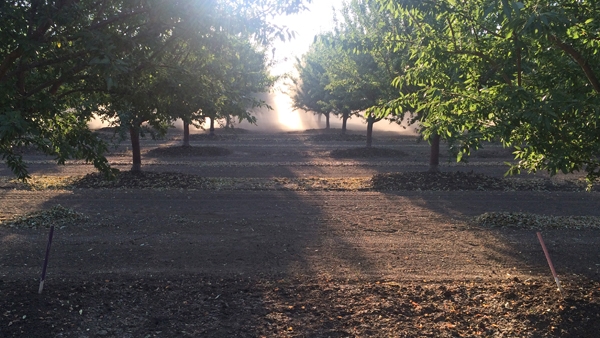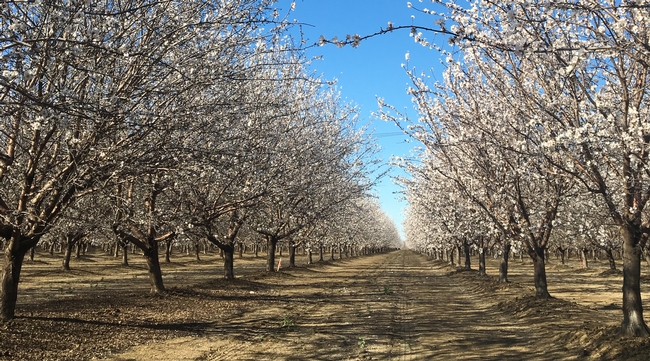Finding a tree that produces the right amount of tasty fruit or nuts under the unique growing conditions of a given orchard takes a lot of science and a little bit of art. It's a mix and match process that involves finding a tree base, or rootstock, that is well-adapted to a particular place and also manages to get along well with the fruit or nut tree cultivar that is grafted to it.
“Rootstocks are incredibly important in agriculture because they help us produce a uniform product under very different growing conditions,” says Katherine Jarvis-Shean, an orchard systems advisor with the University of California Division of Agriculture and Natural Resources in Yolo, Solano, and Sacramento counties. She is researching rootstocks that can tolerate high levels of boron, which she says manifests as a kind of salt toxicity, for the almond, walnut, prune, and pistachio trees she specializes in.
“Boron is an issue up and down the state. Here in the Sacramento Valley, it is found in both soils and irrigation water. Some of that is natural and some of it comes from recirculating irrigation water, which then further concentrates boron in the soil,” says Jarvis-Shean.
“In other areas of California with boron-heavy groundwater, ‘clean' surface water irrigation can help dilute it.” However, this is not the case in the Sacramento Valley. “Here, we have a decent amount of rainfall that helps leach some boron out of the soil. But, it's become a bigger problem with the shift from annual crops like tomatoes and corn to perennial crops like almonds,” says Jarvis-Shean. “Almonds, in particular, tend to build up boron in the tree itself over time, though it doesn't pose any food safety concerns. It does, however, get in the way of yield, which is the thing we care about at the end of the day.”
To carry out her boron-tolerant rootstock research, Jarvis-Shean has been partnering with a grower to trial different options. “We really depend on grower collaboration, and he had been trying to figure this problem out on his own. He was willing to spend some money, in the form of dedicating some land and labor, on the problem in the short-term to have an answer in the long-term,” she says. “We've been able to help with more systematic investigation and analysis.”

“This work was started by my predecessor, and I've continued it now for many years. We grow different sets of rootstocks with the same cultivar on top. We measure the effect of high boron conditions on nutrient uptake, water stress, and basically anything that might help explain yield differences over time,” she says. “Ultimately, the most important measurement comes at harvest.”
Her results have been incredibly valuable. “We've found that the ‘go-to' rootstock here is actually terrible at dealing with boron because it doesn't come from an area where there's a lot of salt build-up. Instead, we've found that peach-almond hybrids are best at managing the high boron conditions here,” says Jarvis-Shean. “We're getting yields that are on par with low boron levels, up to a point. Once you've got a lot of boron, you have to grow pistachios instead. They love boron and that's why we've seen big growth in pistachio acreage.”
In addition to her work on boron, Jarvis-Shean has also researched the effects of a changing climate on agriculture. “My doctoral work was about how tree crops and orchards respond to warmer winters. We studied almonds, pistachios, and walnuts and found if we don't adapt, we will be in a heap of trouble,” she says. “That's especially true with pistachio, cherry, and walnut. Almonds require the least amount of winter cold of any tree crop in California, so they're in a much better position.”
Jarvis-Shean notes that within the next forty years, winters are projected to be warm enough that in roughly a third of the Central Valley, current crop varieties “aren't going to cut it.” However, she says, “With proper support and incentives for breeding programs, we can figure out how to get these crops through a warmer future. It just takes time, energy, and money, and we're doing some of that work now. For example, we're testing chemical treatments that trick trees into thinking that winter has been cooler than it has been.”
In addition to her research on trees, Jarvis-Shean says her work is similar to that of all cooperative extension advisors, which is a grab-bag of issues that are important to the people she works with and include everything from discussing best practices with small, diversified farm operations to thinking about how soil health relates to water infiltration. For example, she explains, “Given that we do get decent rainfall, we'd like to store more water in the ground locally. That provides an incentive for growing cover crops in this area.”
Given the many issues growers in the Sacramento Valley are facing – climate change and labor among them – Jarvis-Shean says water remains a critical issue. “Water will continue to be a big concern for California agriculture. Warmer winters are an issue, but I think with enough time and money we can sort that out. It's a heavier lift to have enough water available and allocated to keep growing all these things, which has always been the case.”
